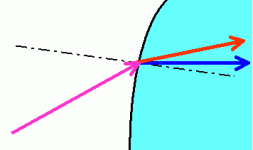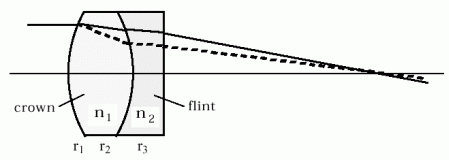The Abbe number.
These web pages are a slightly updated revival of the original KOJAC web pages, that don’t exist anymore on the web site of the Applied Optics Group of IMT (formerly at the University of Neuchâtel, now at EPFL).
Chromatic aberration is due to the dispersion of light in optical materials. The refraction index is not constant, but slowly varies with the wavelength of light. This property can be characterised by the Abbe number defined by:
The Abbe number.
nd, nF and nC are the refraction index values at respectively 0.5876 µm, 0.4861 µm and 0.6563 µm
Thus, the deviation of the light depends on its colour (see figure 1). Lenses are subject to these defects. The focus point is situated at a different place for the different wavelengths, like the red and the blue, and it results in a blurring of the images, among others effects.
Figure 1: Dispersion of the light at an interface.

The achromat is a lens composed of two (or three) lenses, cemented together. One lens is compensating the dispersion introduced by the other. For such purpose, one lens is made in a crown glass (low dispersion, i.e. Abbe number above 50), while the other is made of a flinte glass (high dispersion, i.e. Abbe number below 50) (see figure 2). The crown lens concentrate on the optical effect (for example focusing) and introduces some dispersion, and the second lens aims at balancing this dispersion while having the least possible optical influence on the lens function.
This subject is tackled in chapter 3 (parts 3.8 and 3.9) of “Optique Moderne I” courses.
Figure 2: The achromat principle.

In order to get an achromat, we have to calculate the curvatures from the following equations:
Equations for the achromat


Additionally, the lens shape can be changed in order to minimize the spherical aberration.
The achromat is a lens that is widely used in optics because of its high qualities. Nevertheless, it is a cumbersome lens. A alternative in micro-optics or for low cost systems is the use of an hybrid achromat, where the dispersion of a grating compensates the dispersion of glass while their optical effects are added.
As a side note, we would like to warn the user that we have chosen materials that present high dispersion for visual reasons. The demonstration does not use real material as chromatic aberration is quite small and would not have been visible on the screen.